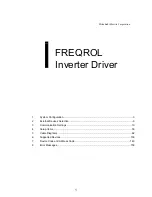
6
-108
Suppressing Short Cycle Vibration
If vibration occurs when the vibration cycle is short, and the cycle is almost identical to the derivative time (D)
set value, the differential operation is too strong. Shorten the derivative time (D) to suppress the vibration.
If vibration continues even when the derivative time (D) is set to 0.00 (D control disabled), reduce the propor-
tional gain (P), or increase the PID primary delay time constant.
Setting Precautions
•
In PID control, the b5-04 constant is used to prevent the calculated integral control value from exceeding a
specified amount. When the load varies rapidly, Inverter response is delayed, and the machine may be
damaged or the motor may stall. In this case, reduce the set value to speed up Inverter response.
•
The b5-06 constant is used to prevent the arithmetic operation following the PID control calculation from
exceeding a specified amount. Set taking the maximum output frequency to be 100%.
•
The b5-07 constant is used to adjust PID control offset. Set in increments of 0.1%, taking the maximum
output frequency to be 100%.
•
Set the low pass filter time constant for the PID control output in b5-08. Enable this constant to prevent
machinery resonance from occurring when machinery adhesive abrasion is great, or rigidity is poor. In this
case, set the constant to be greater than the resonance frequency cycle. Increase this time constant to
reduce Inverter responsiveness.
•
Using b5-09, you can invert the PID output polarity. Consequently, if you increase the PID target value,
you can apply this constant to applications to lower the Inverter output frequency.
•
Using b5-10, you can apply gain to the PID control output. Enable this constant to adjust the amount of
compensation if adding PID control output to the frequency reference as compensation.
•
When PID control output is negative, you can use constant b5-11 to invert the Inverter. When b1-04 (Pro-
hibition of Reverse Operation) is set to 1 (enabled), however, PID output limit is 0.
•
With the Inverter, by setting an independent acceleration/deceleration time in constant b5-17, you can
increase or decrease the PID target value using the acceleration/deceleration time. The acceleration/
deceleration function (constant C1) used normally, however, is allocated after PID control, so depending
on the settings, resonance with PID control and hunting in the machinery may occur. If this happens,
reduce constant C1 until hunting does not occur, and maintain the acceleration/deceleration time using b5-
17. Also, you can disable the set value in b5-17 from the external terminals during operation using multi-
function input set value 34 (PID soft starter).
Response
Before adjustment
After adjustment
Time
















































